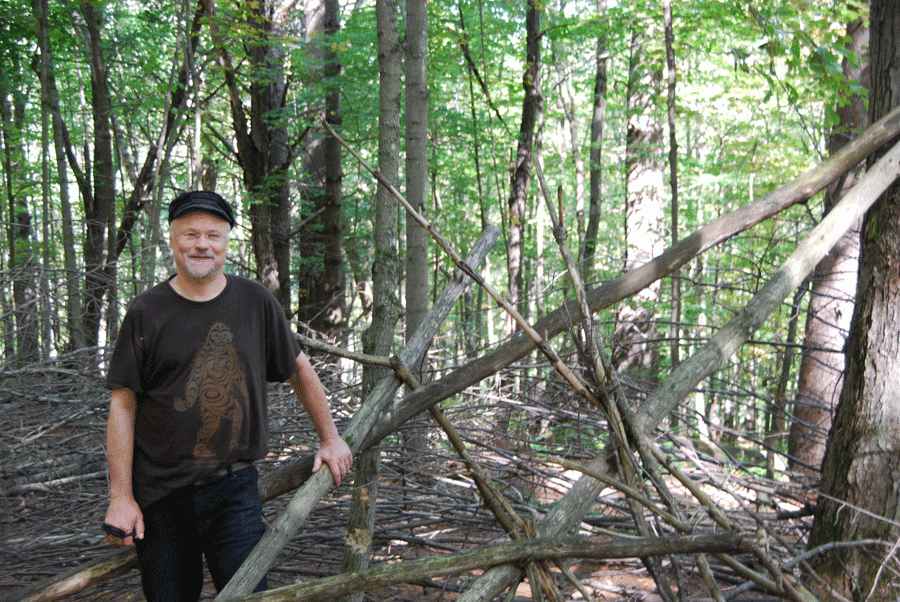Visitors among us: a Vermont writer’s search for Sasquatch
Christopher Noel standing by a Sasquatch structure
The following quote about Sasquatch is a bit long and unwieldy. But Christopher Noël thought it was important enough to edit it as he spoke, even dictating to me where to put parentheses and semicolons.
“Either they simply exist, or else the tens of thousands of eyewitness reports that have been submitted over the decades (often by people who don’t want their names used because they’re afraid of ridicule), all those reports are false. Or if even one of them is true, then probably most of them are true, because it means that the Sasquatch species is real; and if they do exist, they can only have accomplished what they’ve accomplished over the years, in terms of continued disbelief among our species, by being far more elusive than you can possibly imagine.”
Noël feels it’s his responsibility to dispel doubt about the existence of Bigfoot. He has a Facebook group and live YouTube series called Sasquatch and Civic Duty. In fact, he’s organizing a march on the Smithsonian Museum in Washington in 2021, to raise awareness and protest government suppression of information related to Sasquatch. “We hope… there will be laws passed that will make it tantamount to homicide to kill one, because they’re an indigenous people,” says Noël.
He also wants to raise awareness of the public safety hazard of violent Sasquatches, which he says exist, but are extreme outliers. The first episode of his YouTube series also talks about validating the experiences of eyewitnesses, who often doubt their own sanity.
Noël told me all this over tea in the living room of his mother’s house in Montpelier. It sits in a cozy neighborhood, a short walk from a patch of woods that has been the site of some of his most productive Sasquatch research.
“I’ve been fascinated by the subject since I was a kid and saw the Patterson-Gimlin film” said Noël, referring to the most famous footage claiming to be of Bigfoot.
He didn’t follow up on his fascination for many years. But in 1995, when his fiancé died, he explained, “I was in grief, and as part of my kind of attempt to re-engage with life, I flew to…this one town and 90 miles north of Vancouver where there’s been tons of sightings.”
“I spent 10 days up there.” Noël continued. “And I was going to walk in the woods, you know, but then I was so scared of grizzly bears. So I was afraid to go more than 50 feet from the van. So I ended up just driving endlessly along back roads, and playing Bonnie Raitt music and just being sad. And then I started interviewing people in town instead.”
In 2005, he discovered the Bigfoot Field Researchers Organization and started going on expeditions with them. “I went all over the place like Northern California to the great redwood forest, and Florida, twice to the green swamp, and southeastern Oklahoma. All these are separate trips…. I went completely broke doing this because I had been bitten by the bug.”
Eventually, he started hearing about sightings more local to his home in Calais, Vermont, and had what he called “rich interactions” with what he believed to be Sasquatches. One, he says, threw pine cones at him. Another, which he dubbed “Music Man,” would drum on trees, even at 3:30 in the morning.
In his local research, and his expeditions with the BFRO, he found some consistent patterns in his experiences and eyewitness interviews. Eyewitnesses were not believed and often hesitated to go public with their sightings. Government officials wouldn’t validate their reports, often saying that they had seen a bear instead. The Sasquatches themselves would never come into the open in broad daylight but instead would still sneakily interact with humans. Sasquatches’ elusive nature was part of what made him so fascinated.
“It’s like they’re tapping us on the shoulder but they’re on the other side…that kind of trick,” says Noël. “They are so much like us. And yet, also, they’re kind of the ultimate other at the same time, because they stand opposite us. They don’t close the gap. There’s some kind of primordial barrier that they respect, or that they enforce.”
After tea, we headed off into the woods to look at some structures he says are built by Sasquatch. There are a couple different types of structures, but if I take his Sasquatch conceit at face value, I can see a common aesthetic. The structures take the form of branches leaned up against trees, or interwoven with each other. Sometimes it’s a tree bent over with the top pinned to the ground by some other bit of forest debris. The branches are usually barkless. Sometimes there are small branches and leaf or needle matter stuck in elevated nooks.
These are the types of structures I would not think twice about on a stroll in the woods. If I happened to stop to think about them, I would probably attribute them to wind, or people, or other animals. But Noël points to things that he says people and weather wouldn’t do. A curved log stuck into a gap in a tree in a way that he says would require placement. A tree with a trunk too thick for humans to snap, bent in a direction that it wasn’t naturally leaning. Pine needles stuffed into a tree too high for humans. “I mean, you could bring a ladder out here. But why on God’s green earth would you do that?” he says.
Noël insists on doing audio verification to test for Sasquatches in the area. After finding structures, he will set out an audio recorder overnight. He’s listened to 340 hours of audio from these woods and found sounds he says could only come from Bigfoots. He says he’s heard howls with a phoneme shift that animals in the canine family can’t make (“ooo-aaa” instead of just “ooh”). The most common one is wood knocks, which he says could come from a human, but no one would do it so consistently at all times of night.
Okay, so is this legit? Are there Bigfoots roaming the woods in Montpelier? Unfortunately, I am in no way qualified to answer that question. He’s devoted the last 14 years of his life to Sasquatch. I’ve only met one other cryptozoologist and done some casual Googling. I’ve never talked with any serious Sasquatch debunkers. However, we did talk a bit about his research methods.
Noël has some confirmation bias. I suggested that he compare notes with Tom Wessels, a Vermont natural historian and author of the book Forest Forensics. Noël said, “He’d probably know another explanation,” but didn’t stop to ask if that explanation might be more valid. He hasn’t done much testing of alternate hypotheses or negative confirmations.
But Noël is also hampered by a lack of scientific infrastructure for Sasquatch research. He had to forge his own path, and the research is labor intensive. And even if he tried to publish in a journal, who would peer review an article about Bigfoot? I asked him if he had ever tried to disprove his hypothesis by putting a recorder in a place that’s not likely to have any Sasquatch (a small patch of woods in the middle of a city, for example). He replied, “Yeah, I haven’t done that…. Any sort of place where you don’t, you can’t rationally expect you’re going to get any anything interesting, and then sitting there for hundreds of hours listening and not getting anything interesting, is not the way I want to spend my life. Although, if there were a team of scientists… like, the intern could do that.”
When I asked Noël about his life outside of Sasquatch research, he said, “I’m a father. I play basketball three times a week. It’s not interesting.” Like many Vermonters, he makes his money in a hodgepodge fashion. He used to teach at a college, and sometimes substitute teaches, but he said most of his money comes from freelance editing. “If I have editing to do, I’m a very happy camper because I sit there and I make money sitting on my butt at the computer editing while listening to Sasquatch habitat audio.”
Noël says it can be stressful trying to make ends meet with so much of his time devoted to Sasquatch on top of the normal hassle of being a freelancer. “But,” he says, “you know, on my deathbed, I’m not gonna look back and say, I wish I had less financial stress and not done this Bigfoot thing? Because this is my calling.”
If you’ve had any interactions with a Sasquatch, you can email Christopher Noël at [email protected]. You can also contact him if you want to march on Washington with him. Or be his intern.

Senior, Professional Studies
Grew up in East Montpelier, VT
Fall 2019 - Present
In my spare time that I pretend I still have, I play saxophone...




Rae Marie Nutting • Oct 4, 2019 at 1:56 pm
I’m a VT girl. Have lived here all my life. I’ve had seven sightings. (Within 3-60
Feet). Different individuals. Singely and as a group. Never an aggressive experience. I’ve had many experiences that I didn’t see them but knew they were there teasing me or interacting w/me. My area is in the town if So Royalton Sharon and Strafford. I never went looking. They found me. I am blessed